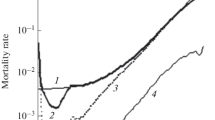Abstract
The standard human population pyramid contains only current information; it is often inadequate when making comparisons of different countries or years. A graphic computer program superimposes current population, life table survivor ships, stable population, and past population projected up to the present. Fertility, health conditions, migration, and demographic transition stage are better revealed by this expanded graph form. A time series of the modified pyramids reveals detailed age-specific trends for a country or region. With ’minor modifications the computer program is applicable to all machines with a Fortran IV compiler.
Similar content being viewed by others
References
Boughey, Arthur S. 1973. Ecology of Populations. New York: Macmillan.
Boughey, Arthur S, D. Wilkin, and J. B. Pick. 1972. Hydrology and the Water Use in Kern County: A Modelling Study of Human Carrying Capacity. Unpublished paper presented at the Eighth American Water Resources Conference, October 3O–November 2, 1972, St. Louis.
Demko, George, and Carl E. Young man. 1973. Computer Display and Demographic Process: A Demonstration. Unpublished paper presented at the annual meeting of the Population Association of America, New Orleans, 1973.
Goodman, Leo A. 1967. On the Age-Sex Composition of the Population that Would Result from Given Fertility and Mortality Conditions. Demography, 4:423–441.
Handler, Philip, and Judith Sherwood. 1972. The Plato System Population Dynamics Course. In T. N. E. Greville (ed.), Population Dynamics. New York: Academic Press.
Keyfitz, Nathan, and Wilhelm Flieger. 1971. Population: Facts and Methods of Demography. San Francisco: W. H. Freeman and Co.
—, and Wilhelm Flieger. 1968. World Population: An Analysis of Vital Data. Chicago: University of Chicago Press.
United Nations. 1950–1971. Demographic Yearbook. Various issues. New York: United Nations.
U. S. Bureau of the Census. 1960. Historical Statistics of the United States: Colonial Times to 1957. Washington, D. C.: Government Printing Office.
— 1965a. Estimates of the Population of the United States and Components of Change by Age, Color, and Sex, 1950 to 1960. Current Population Reports, Series P-25, No. 310. Washington, D. C.: Government Printing Office.
— 1965b. Historical Statistics of the United States: Colonial Times to 1957; Continuation to 1962 and Revisions. Washington, D. C.: Government Printing Office.
— 1971. Census of Population: 1970. General Population Characteristics. Final Report PC(l)-B. Various volumes. Washington, D. C.: Government Printing Office.
U. S. Bureau of the Census. 1974. Estimates of the Population of the United States by Age, Sex, and Race, April 1, 1970, to July 1, 1973. Current Population Reports, Series P-25, No. 511.
Author information
Authors and Affiliations
Rights and permissions
About this article
Cite this article
Pick, J.B. Computer display of population age structure. Demography 11, 673–682 (1974). https://doi.org/10.2307/2060477
Issue Date:
DOI: https://doi.org/10.2307/2060477




